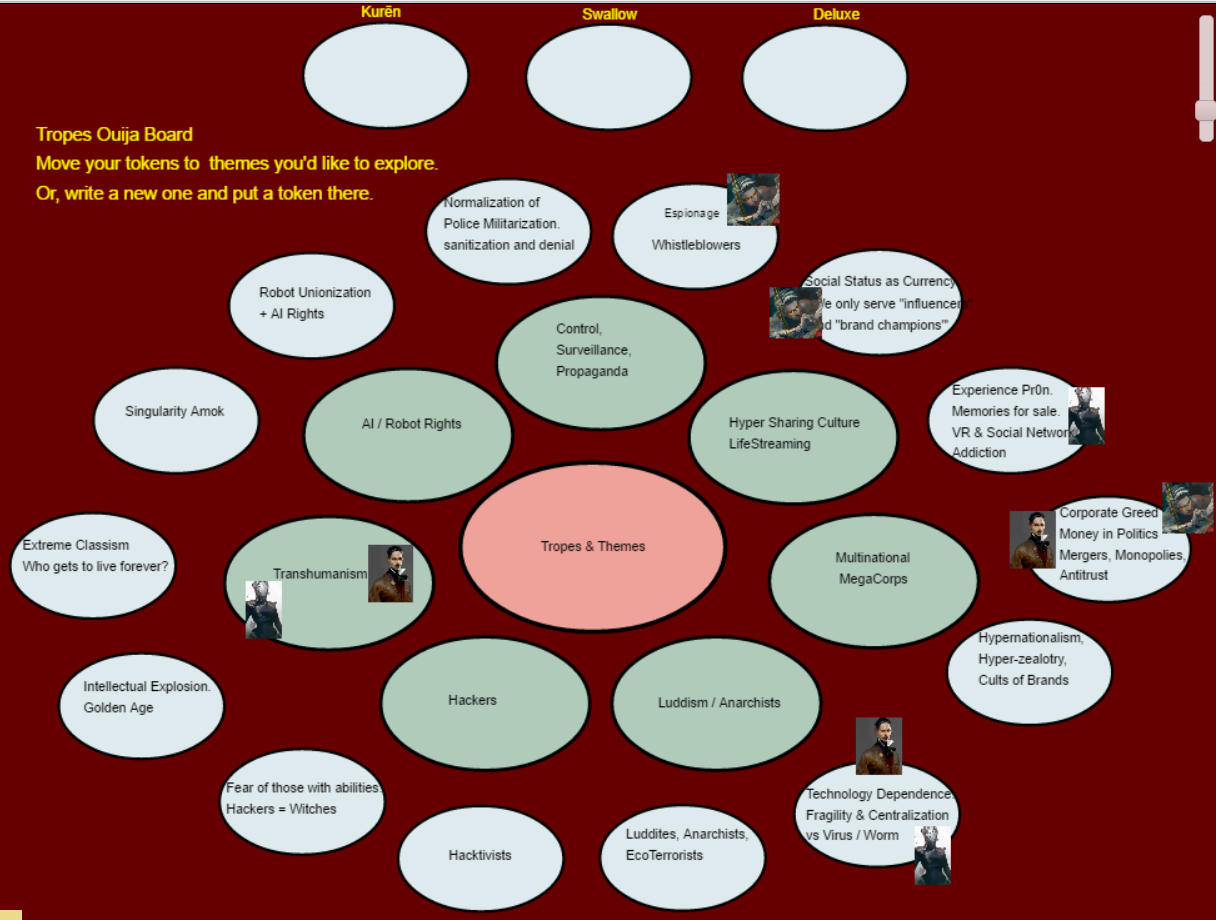
Actual Play Report:
I hosted a one-shot of The Veil today. We had an Architect, a Catabolist and an Executive.
The Executive drove play because their session start move provided two mandatory missions.
1. Protect a visiting dignitary so the corporation could get permits to operate in that region.
2. Track down the cult leader of a socialist commune of anarcho-luddites who’s message was hurting the Brand.
Right away the executive parcelled out the work so he could get both missions done. He protected the dignitary while the Architect and Catabolist went after the cult-leader.
The dignitary wanted to be entertained, and he demanded some illegal memory recordings.. much like in Strange Days. The mission then became acquiring those goods from the seedy part of town.
Our Catabolist was an academic lecturer advocating transhumanism. He had been involved in the expulsion of another academic who followed the works of that luddite cult leader. To locate the cult, he had to reach out to the very man he got fired.
The Architect was an artist who beautified everything she came across. But she regretted a lost love, which manifested and continued to haunt her. This caused problems when she encountered figments of her past during the mission to track down the cult-leader.
Bugs:
The character sheet on Roll20 didn’t add the stat modifier unless the additional modifer field also had a value (It had to be 0 instead of blank because “2d6+2+” fails, but “2d6+2+0” works). We didn’t notice this until a few rolls in. (I’ve since modified the character sheet to put in a default 0 value in that field, but it’s still something to be aware of.)
In the playbook reference, the Executive Giri questions don’t seem right. They’re the same as the Architect.
Other Things to be aware of when running a game:
The architect needs to be rolling dice. That’s how their subconscious figments come into play. At the start of the game, I wasn’t making them roll for manipulating the environment, thinking I’d make them roll when the stakes were higher. But without rolling, their regrets never manifest themselves.
The PCs didn’t all buy-in to the Executive’s mission, so the Executive had to use Giri or Cred to get everyone involved. This is working as intended, but it feels strange when you’re used to “we all meet in a tavern” or “Here’s your mission, Go!”. Be ready to ask people to spend their Giri.
Humanity harm was a bit confusing. If there’s no Empath, when do you roll it, exactly? We let players volunteer when it comes into effect for their characters, which worked ok.
The game feels intended for longer campaigns. We had some challenges weaving the characters together and giving them common purpose in a one-shot. We started in media res, but the “Call to Action” felt forced. The question: “In this high-stakes situation, why wouldn’t the characters just scatter and go back to their normal lives?”, was never settled. It turned out the Executive’s Giri was a better call to action than the GM’s in media res scene.
All in all: The game was really good. I really like the far-forward setting with trans-humanism, persistent Augmented Reality, and all the other tropes.
Here’s our tropes board:

One more thing: our Catabolist never used junkware or scrounge. Not sure if that’s a problem with the playbook or our playstyle. It might be that, as GM, I didn’t have the playbooks memorized, so I didn’t call for moves when they would have been appropriate. Compounded with polite players who don’t ask for specific moves because they assume the GM is already aware of them.
Sounds super fun! I love Strange Days, gotta rewatch that sometime soon!
The Giri questions on the Architect are the same as the executive? That was a problem that was corrected before, maybe it needs to be uploaded again though if it’s still showing those. I remember that from a change log so I’ll have to double check drivethru accepted that latest update.
You’re right about it being geared towards long play, a lot of it is geared towards people having time to have their character emerge through play, a one shot is going to naturally bulk some of the long term elements, similar to Urban Shadows I think.
Humanity harm is usually PC on PC but it’s meant to have a character really come to grips with something intense and intrinsic to their identity, only a few playbooks can choose to inflict it and usually you’d have to know another character well to do it, but when there are those kind of powerful moments it’s enforced mechanically now is all.
With pbta games to do it, you do it so I’d say the players are more needing to hit their specific moves. If the MC knows them all well they can remind them and look out for opportunities but there are so many playbooks I’d find that daunting if I were MCing it for the first time.
It’s really inspired by AW where it’s all about having the players have a lot of fiction with the playbooks so they could support their own storylines that can but don’t have to collide with others all the time, so the group doesn’t have to be a traditional party doing a group activity. But as a one shot that’s certainly what you’ll want to do or not much would get done.
Someone was saying the Mad state is rolling with advantage. Any chance of rectifying that?
Just got back from Vacation. I’ll look into the Mad stat problem now.
Thanks!! Sorry for the trouble.